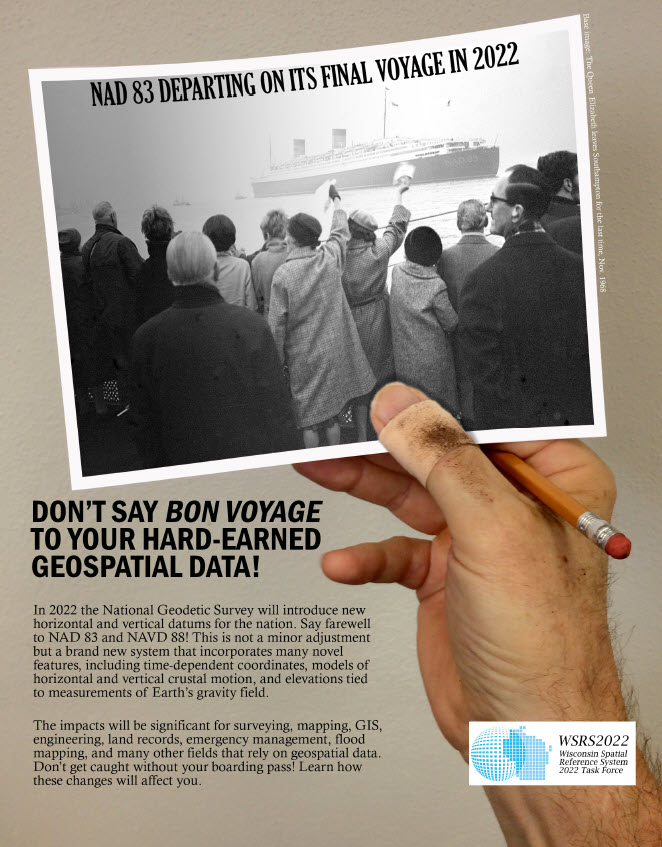On August 15, 2019, the Wisconsin Spatial Reference System 2022 Task Force (WSRS2022) submitted a letter to the National Geodetic Survey (NGS) requesting exceptions to NGS’s policy regarding the modernization of the State Plane Coordinate System (SPCS) associated with the introduction of a new terrestrial reference frame in 2022.
Details on the letter — including the full letter text — can be found in this earlier Wisconsin Geospatial News article or on the WSRS2022 webpage.
In early October, WSRS2022 received a response from NGS. The full text of that response is on the WSRS2022 webpage here. A summary of the response is here.
To summarize, our August letter requested the following:
1. That NGS design a statewide single-zone layer which is a Transverse Mercator projection with its central meridian at 270° east longitude and has a false easting significantly different from those of WTM 27 and WTM 83.
2. That NGS design a default three-zone layer for Wisconsin.
3. That, if the NGS design must have a central meridian at a longitude other than 270° east to better fit the topographic surface, then the longitude difference be taken into account when selecting the false easting to be significantly different from those of WTM 27 and WTM 83 (for the single-zone layer) and those of SPCS 27 and SPCS 83 (for the three-zone layer).
4. An exception to any NGS specification that conflicts with WISCRS.
5. An exception to the requirement for completion of the fully detailed online design submittal form.
6. An exception to SPCS2022 Policy 2.a. that only one multi-zone layer can provide complete coverage of an entire state.
In brief, the NGS responses to our requests were as follows:
1. No exception is required for our requested statewide single-zone layer specifications.
2. WISCRS zones are in conflict with SPCS2022 procedures for a minimum zone width of 50 km. However, because of the long established use of WISCRS, this exception request is granted. The small zones of WISCRS are allowed.
3. WISCRS uses 59 projection definitions for 72 zones. Thus projection definitions are not unique, which is in conflict with SPCS2022 policy and procedures. All zones in the LDP layer must have unique parameters, meaning that there will be 59 rather than 72 zones for WISCRS.
4. Modifying zone parameters to satisfy all SPCS2022 policies and procedures (other than minimum zone size) is required by NGS.
5. The requested exception to not submit a detailed design package is not granted. Wisconsin must submit a detailed design package for each zone including a single coordinate and linear distortion for each zone.
6. The request for three statewide zones is not granted. Only a single-zone statewide layer and a 59-zone LDP layer are permitted.
In sum:
1. NGS has no objections to our design preferences for a single-zone statewide layer.
2. NGS will not design a three-zone layer for Wisconsin.
3. NGS will allow us to keep current our WISCRS zones even though they are smaller than NGS specifications. However, only the 59 unique zones will be recognized, not the 72 zones for each county. Thus each of the 59 zones will effectively need to be named in a way that represents all of the counties within the zone.
4. NGS will require all WISCRS parameters (e.g., projection axis scale significant digits, false northings and eastings, latitude and longitude parameters specified to nearest whole arc-minute, etc.) to conform to NGS specs. This would necessitate a redesign of WISCRS.
5. NGS will require us to submit a full design package for each zone.
WSRS2022 is currently evaluating options. To distill things down even further, we essentially have a choice between two options:
1. The “Status Quo” — NGS will design a three-zone layer for Wisconsin, but WISCRS will not be included in NGS data sheets or software.
2. “NGS-compliant” — NGS will NOT design a three-zone layer for Wisconsin, but WISCRS will be included in NGS data sheets and software (with some redesign of WISCRS needed).
In either case, we will still need to update coordinate transformation software tools like SDMS since the existing NAD 83 version of WISCRS will not be in the NGS ecosystem.
The next meeting of WSRS2022 is planned for the morning of Wednesday, Nov. 6, at a location to be determined.

